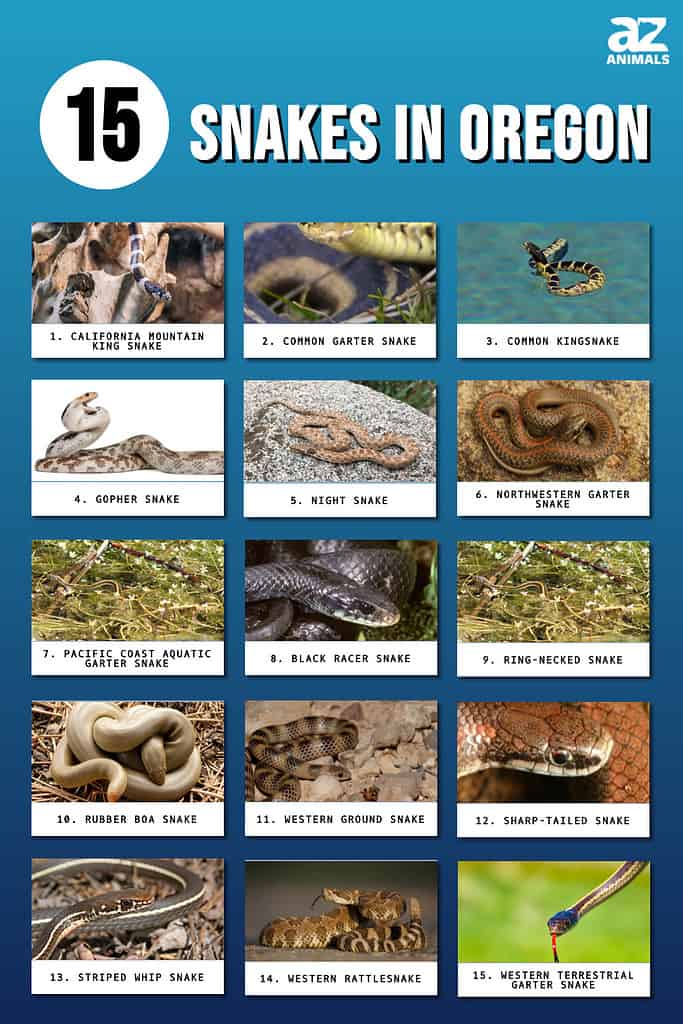
Oregon has a unique landscape with some of the country’s deepest canyons and lakes and the Cascade Mountains running through one end of the state. The Colombia Plateau, which takes up the entire eastern part of Oregon, is home to Hells Gorge, the deepest canyon in the country. There are six separate geographical regions in Oregon. These regions attract various types of wildlife, including 15 snake species that live in these varied habitats. Oregon’s snakes are spread throughout the state, with each unique region attracting different types of snakes that thrive in that particular habitat.
Most of Oregon’s 15 snakes are harmless and beautiful. Snakes are mostly shy and avoid humans instead whenever possible. However, any animal will bite if it feels cornered or threatened. Give the snakes a little space, and they’ll go. A few of the common snakes you will see in Oregon are:
Gopher Snake
Gopher snakes are master bluffers. They have a similar color pattern to a western rattlesnake, with similar defensive behaviors. They mimic venomous rattlesnakes, so predators will assume they are dangerous and leave them alone. However, gopher snakes have smaller heads than the rattlesnakes they mimic; they also lack the rattle.
In Oregon, gopher snakes are found mainly in the central part of the state. They don’t go near the coast and stay below about 6,000 feet.
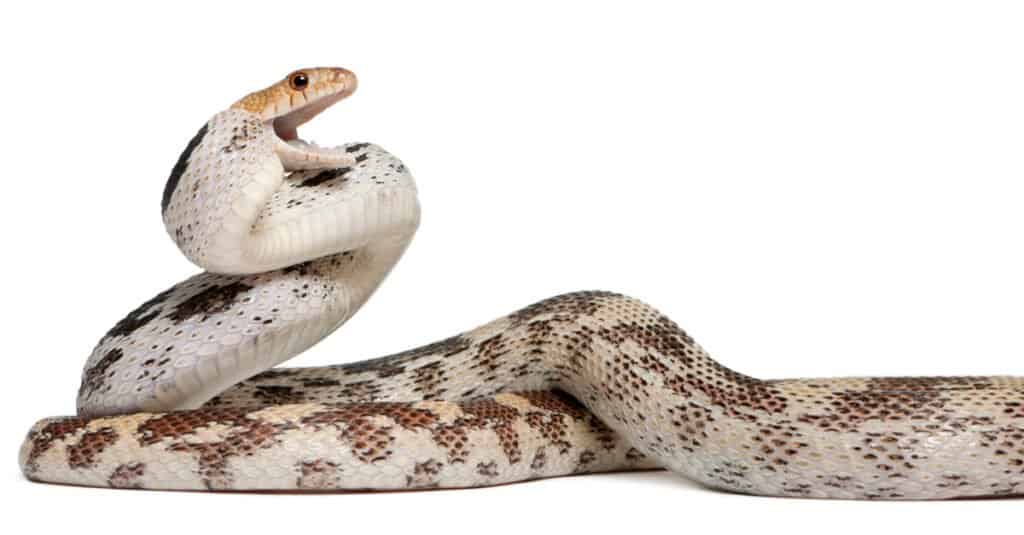
Gopher Snakes mimic venomous rattlesnakes, so predators will assume they are dangerous and leave them alone.
©Eric Isselee/Shutterstock.com
Night Snake
One of the signature features of a night snake is that it’s tiny. These snakes are typically about a foot long but can be up to two feet long.
They are called night snakes because they are nocturnal and only move around or hunt at night. Unless you’re fishing early in the morning or getting an early start on a hike, you will probably never see a night snake, even if they are hiding nearby.
They have very light coloration and a gray or beige base body color with contrasting patches down the length of the body. These snakes only eat frogs and lizards.
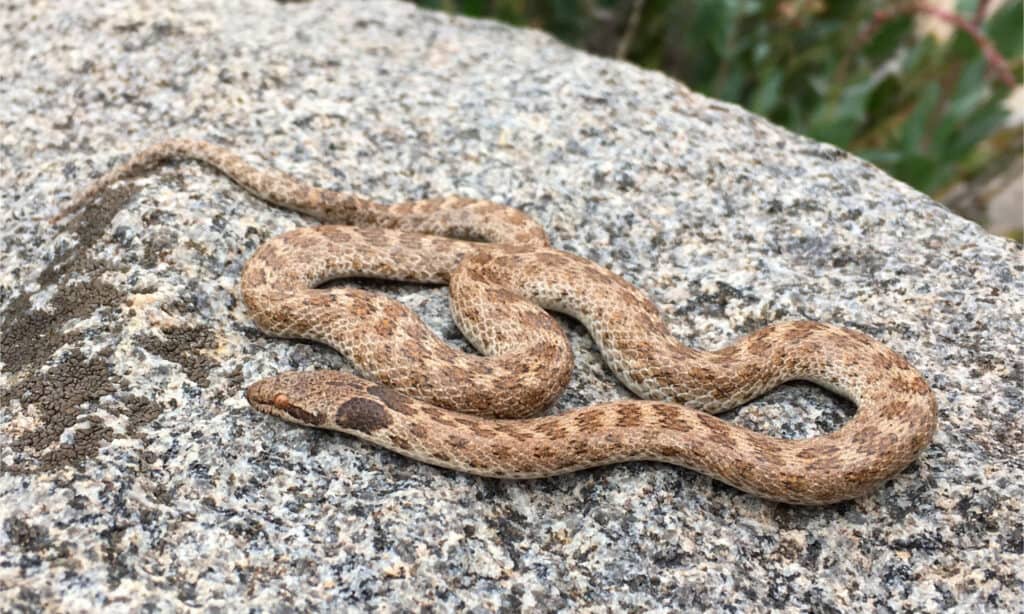
Night snakes have two large brown splotches behind their heads.
©Matt Jeppson/Shutterstock.com
Aquatic Garter Snake
Aquatic garter snakes are highly aquatic. They prefer to hide by diving under the water and don’t like to be on land at all.
These garter snakes are small at about a foot and a half long. They can have several different colorations, but the most common one is dark olive with brown undertones and sometimes a yellow stripe along the length of the body.
Because this snake is aquatic, it’s found mainly in Oregon’s lakes, rivers, or streams. Their diet is typically tiny fish and frogs.
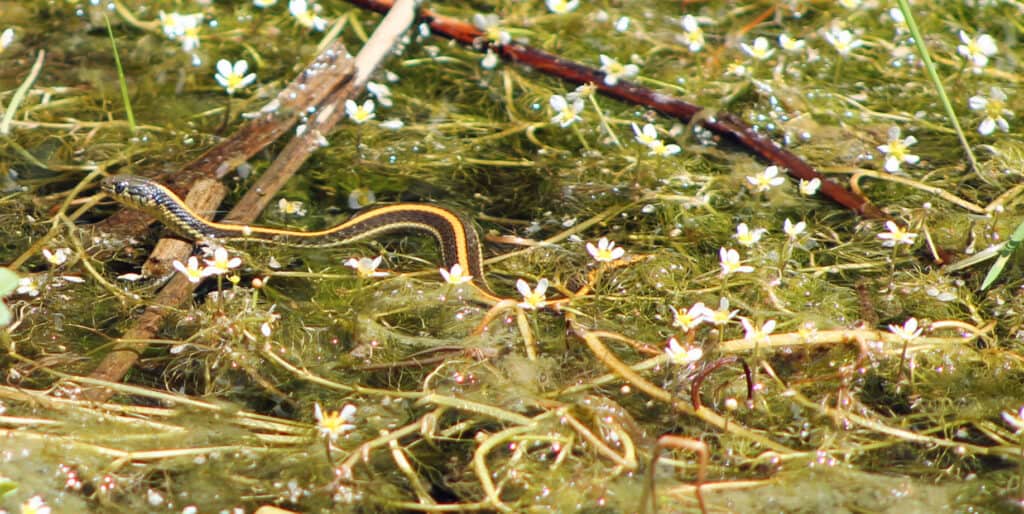
Aquatic garter snakes spend more time in the water than other garter snakes.
©Sarah Stierch / CC BY 4.0 – License
Ring-Necked Snake
You must look carefully to see a tiny ring-necked snake because it can be as small as 10 inches long. In Oregon, you can find ring-necked snakes primarily in the southwest part of the state, like in the Willamette Valley and the lower Deschutes River Valley. They need a very moist environment to thrive, just like their typical prey of earthworms, slugs, and snails. So, you’ll usually find them in fallen trees, leaf piles, mulch, or even outdoor potted plants.
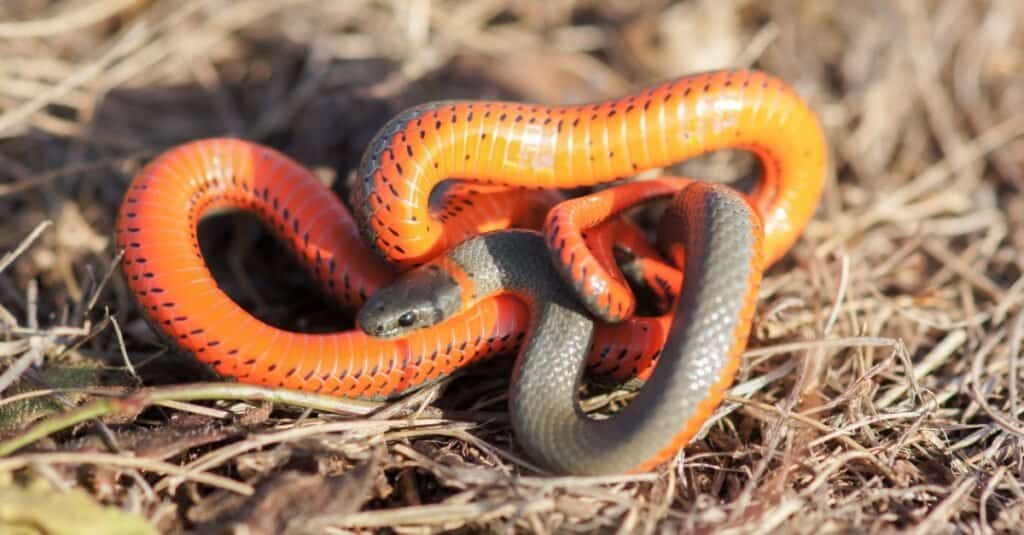
Small and colorful, the ring-necked snake is nocturnal and non-venomous.
©yhelfman/Shutterstock.com
Striped Whip Snake
Striped whip snakes slither very quickly and have a unique way of moving that is similar to a sidewinder. They are typically long and thin with a dark base color and two long lighter colored stripes that run the length of the body. Their preferred habitat is sagebrush, grasslands, and dry areas. However, you can also find them living along the bottoms of canyons. Since there are a lot of canyons in Oregon, be careful when hiking or exploring a canyon.
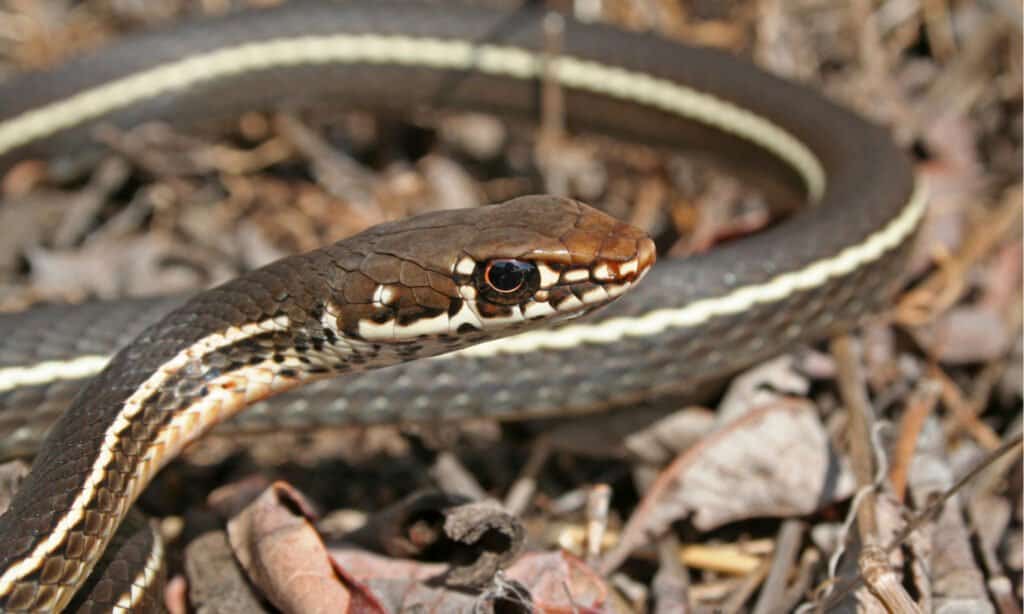
Striped Whip Snake prefers sagebrush, grasslands, and dry areas. This snake also lives at the bottom of canyons.
©Creeping Things/Shutterstock.com
Rubber Boa Snake
The boa with a silly name is one of the most docile snakes in the world. Rubber boas are much smaller than other types of boas and usually only grow to about 24 inches long.
They have a heavy wide body with uniform gray to brownish coloration. Their tiny scales are shiny and look like rippling rubber, which is where they get their name.
Rubber boas are common across most of Oregon, except in the north near Coos Bay. Although they can climb, they’re a more fossorial snake, so you’re not likely to find them off the ground. Like many snakes, rubber boas eat a lot of rodents — mainly small rats and shrews.
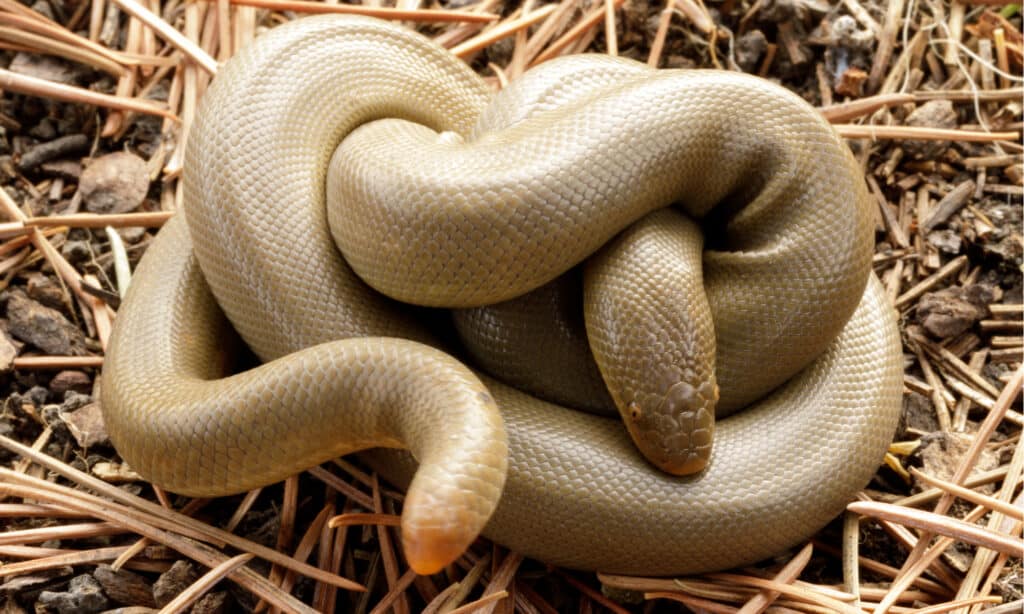
Rubber boas look almost the same at their heads and their tails.
©yhelfman/Shutterstock.com
Venomous Snakes In Oregon
Although this may surprise you, there is only one type of venomous snake in Oregon. The western rattlesnake is the only venomous snake in Oregon.
This rattlesnake has a very light base color of either tan, pale white, or light brown to blend in with its surroundings. It also has distinct oval or circular markings in a darker color, bordered by dark brown or black. Like other rattlesnakes, western rattlesnakes have big chunky heads, thin necks, and stout bodies that end in rattles.
These snakes prefer to live in dry, warm places where they can hide in the crevices of rocks. You can find them primarily in Hells Gorge and other canyon areas in Oregon. But you can also find them in the Cascade Mountains and Mt. Hood.
Stop moving if you surprise a Western Rattlesnake as you’re hiking or walking. Rattlesnakes will strike when they are surprised or feel cornered, but first, the snake will probably coil and rise, then rattle, trying to get you to leave it alone. Stop and wait so the snake sees you are not a threat, then slowly back away.
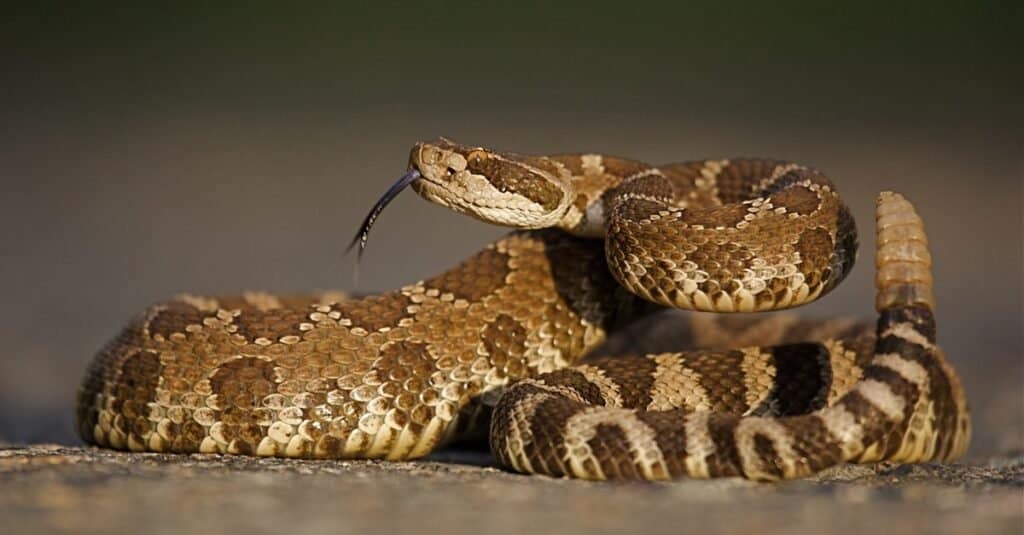
This Western Rattlesnake is coiled with rattle erect and forked tongue extended.
©Tom Reichner/Shutterstock.com
Summary Of 15 Snakes In Oregon
Oregon doesn’t have a particularly large population, but it is a popular destination for people who love the outdoors. Oregon is a unique state because you can hike up Mt. Hood or through the Cascade Mountains and, on the same day, go to Hells Gorge and look into the deepest canyon in the country. But no matter what type of outdoor activity you’re enjoying in Oregon, be on the lookout for these 15 different snakes:
| Number | Snake |
|---|---|
| 1 | California Mountain King Snake |
| 2 | Common Garter Snake |
| 3 | Common Kingsnake |
| 4 | Gopher Snake |
| 5 | Night Snake |
| 6 | Northwestern Garter Snake |
| 7 | Pacific Coast Aquatic Garter Snake |
| 8 | Black Racer Snake |
| 9 | Ring-Necked Snake |
| 10 | Rubber Boa Snake |
| 11 | Western Ground Snake |
| 12 | Sharp-Tailed Snake |
| 13 | Striped Whip Snake |
| 14 | Western Rattlesnake |
| 15 | Western Terrestrial Garter Snake |
The photo featured at the top of this post is © yhelfman/Shutterstock.com
Discover the "Monster" Snake 5X Bigger than an Anaconda
Every day A-Z Animals sends out some of the most incredible facts in the world from our free newsletter. Want to discover the 10 most beautiful snakes in the world, a "snake island" where you're never more than 3 feet from danger, or a "monster" snake 5X larger than an anaconda? Then sign up right now and you'll start receiving our daily newsletter absolutely free.
Sources
- (1970)
FAQs (Frequently Asked Questions)
Is there any venomous snakes in Oregon?
The Western Rattlesnake is the only venomous snake in Oregon.
Where are rattlesnakes located in Oregon?
Oregon’s snakes are spread throughout the state, with each unique region attracting different types of snakes that thrive in that particular habitat.
What is the largest snake in Oregon?
The Western rattlesnake is the largest snake in Oregon.
Thank you for reading! Have some feedback for us? Contact the AZ Animals editorial team.







